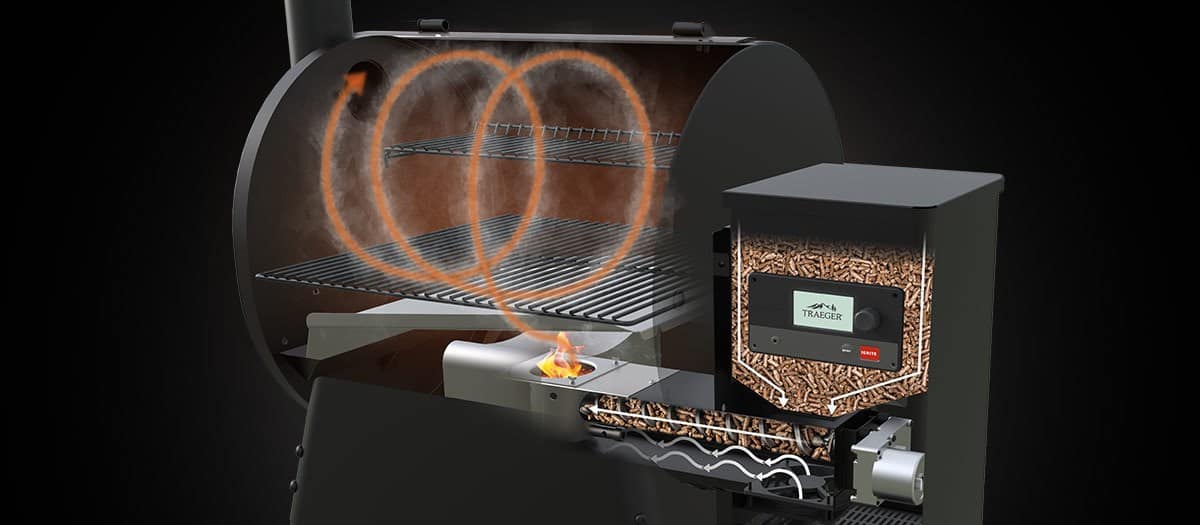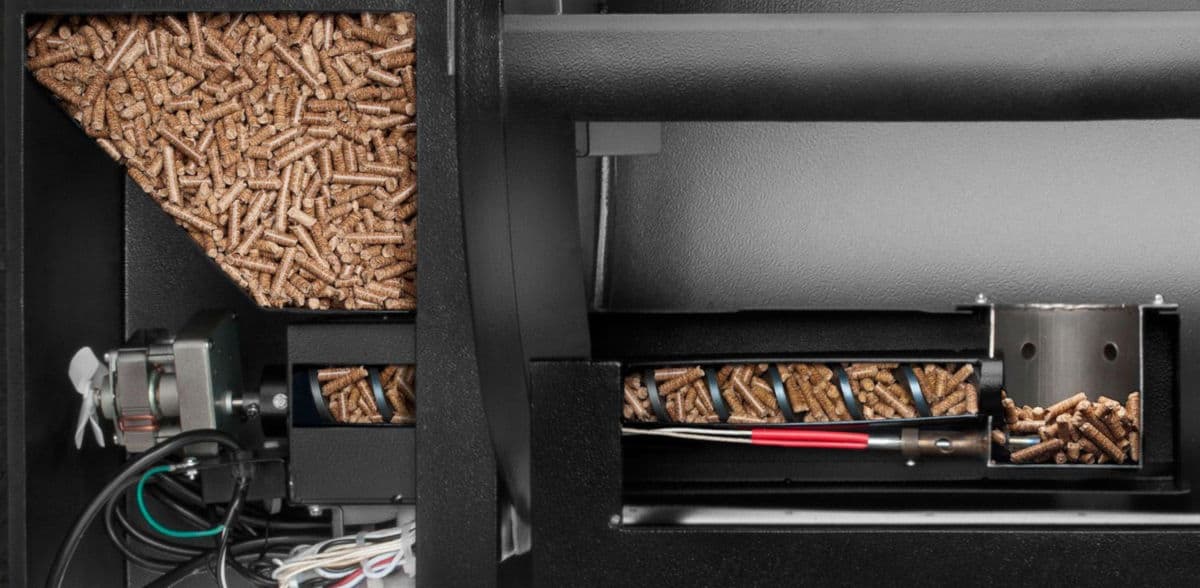
In this article, we’re going to answer the questions: What is a pellet grill? And how do pellet grills work?
Not everybody knows what they are, and that’s likely how you found yourself here after searching for the answers.
Now, there’s a very graphic phrase that says, “There’s more than one way to skin a cat.” The meaning is that there are usually multiple ways to complete any task.
And, that completely applies to barbecue.
Most people get their start with barbecue on a basic charcoal or gas grill. But, there’s a host of other ways to get the job done, including pellet grills.
But not everybody knows about these relative newcomers to the barbecue world.
Today we’re going in-depth to teach you what a pellet grill is and how they function. We’ll cover some pros and cons of pellet grills, too.
In the end, you’ll have a better idea of whether this type of grilling is for you.
Contents (Jump to Topic)
What is a Pellet Grill?
Despite a surge in popularity over the last few years, a pellet grill is still an unfamiliar item to many, which is a shame as it’s possibly the best smoker for beginners. So, let’s give them a definition and explain the features and benefits.
A pellet grill, sometimes called a pellet smoker, is a wood-fired, electric-powered, automated device for cooking food at either low or moderately high temperatures using indirect, radiant heat by burning wood pellets made for smoking.
They look a little like a cross between a standard barrel shaped grill, and an offset smoker.
They range in price from $350 and up for small portable pellet grills, to anything from $700 to $3,000 or more for full-sized pellet grills capable of cooking for small to large crowds.
The rest of this article discusses exactly how pellet grills work. We have a companion article with 9 pellet grill tips and tricks to get most out of one if you are, or are soon to be an owner.
How Does A Pellet Grill Work?

Now you know what a pellet grill is, here’s what it does and how it does it.
Wood Pellets
The fuel source for pellet grills, the humble wood pellet is a small, essentially cylindrical bit of compressed sawdust. Made from lumber industry waste, their original use was for home heating.

Wood pellets for cooking are made of 100% hardwood and contain no added combustion or binding agents. Therefore, burning them is no different from burning wood in any form. It is, however, cleaner than burning charcoal.
Pellets burn very efficiently, leaving behind shockingly little ash. You can buy them in a variety of flavors, just like you would when selecting chips or chunks. So depending on the intensity of flavor you are looking for, you can buy mild fruit woods, to very strong mesquite, and many different flavor woods in between.
Be sure to choose only hardwood pellets explicitly made for cooking. Home heating pellets may contain chemicals or softwoods that release toxins. There is no good recipe for toxins.
As Meathead Goldwyn of Amazing Ribs points out, the hotter you burn pellets, the less smoke they produce.
They put out their best smoke at about 250F. As they burn hotter, however, there’s less and less of it. While that might seem like a problem, it’s precisely the opposite. For example, you can bake in a pellet grill. Do you want a smoky pie?
The Hopper

Mounted on the side of the pellet grill, the hopper is the repository for your supply of hardwood pellets.
Sizes vary from model to model, but 12 pounds is an average capacity. As we’ll learn in the next section, pellets are automatically dispensed from the hopper as needed to maintain the preset ambient temperature inside the cook chamber.
Unlike with other types of smokers, there is no need to lift the lid over either the firebox or the cook chamber to add more wood in the middle of a cook session. This means there is zero heat fluctuation during a top-up.
The Auger
Pellets dispensed by the digital controller are shuffled along to meet their fiery demise by an auger.
An auger, if you’re not familiar with the term, is a very large screw. As it rotates in place, pellets inch forwards towards the fire pot for ignition.
The auger, in combination with the digital controller, is what makes a pellet grill unlike any other cooker on the market.
The Digital Controller

Here’s the part that makes pellet grilling so user-friendly.
Just like you do with your oven, set a target temperature at which you want your food to cook. Designs vary, but typically you’ll have a digital temperature control, where you simply key in the temperature you desire, and can then see the actual measured temperature on an LED or LCD.
A sensor probe inside the grill monitors the ambient temperature. If it’s below target, the digital controller dispenses more pellets for burning. When it’s on target, the controller watches the situation and waits until it’s needed again.
Some units include a meat probe, so you can keep tabs on what’s cooking. That’s a nice bonus and might save you the cost of a 3rd party smoker thermometer.
The Fire pot

At the end of their journey from the hopper, the auger dumps the pellets into a small fire pot.
Here, an electric igniter rod warms up the pellets until they begin to smolder, creating heat and smoke.
Above the pot, a deflector plate distributes the heat around the inside the grill, all but eliminating any hot spots. It also shields the fire pot from any drippings from the cooking food, keeping fats and oils away from the naked flames and preventing any flare-ups.
The Fan and Blower
Of course, there’s no fire without oxygen. For that reason, pellet grills come equipped with a fan and blower system to pull air from outside the cooker into the fire pot.
When extra heat is required, the fan kicks in to deliver more air and stoke up the pellets. It’s not dissimilar to opening and closing vents on a kamado or charcoal smoker, to adjust the airflow and hence the temperature.
The Chimney

Either at the back of the cooking chamber or on the opposite end to the hopper, you’ll find the chimney.
The chimney allows the smoke to exit the chamber, preventing over-smoking. It also allows for airflow, creating a ‘draw’ that ensures the smoke passes over all the food before it escapes.
As heat escapes out the chimney, it takes with it stale smoke, preventing it from hanging around, ensuring only fresh smoke hits and flavors your food.
Pros and Cons of Pellet Grills
Pros
- Many cooking options, including smoking, roasting, and baking.
- Even cooking of large quantities of food thanks to convection.
- Real wood smoke with minimal chance of over-smoking.
- Set-and-forget controls make smoking easy and accessible, with almost no learning curve for new users.
Cons
- Low smoke output at higher temperatures.
- Mechanically complex with moving parts and digital controls that may break down in time.
- Requires a handy source of electricity.
- Cannot be used in the rain.
- Without direct heat, searing is not possible.
Final Thoughts
Pellet grills combine many of the best features of both smokers and grills and offer much versatility when it comes to backyard cooking.
While they can’t quite replicate the searing power of a standard gas or charcoal grill, they can do pretty much everything else.
The best way to look at pellet grilling, is it’s a user-friendly smoker with options, and not as a single-unit solution for all types of backyard cooking.
Want to know more?
Be sure to check us out for more information on pellet grills, including detailed reviews of the best models.
And, we’ve got tons of articles covering all things barbecue. Browse to your heart’s content, and share freely with your friends and family.






Why can’t you use a pellet grill in the rain? Other than concerns about electricity, you label it as a con but didn’t address it in the article.
Hi, JoeFab. Yes, concerns about electricity is it. The controllers and displays aren’t waterproofed, so are liable to break due to water ingress.